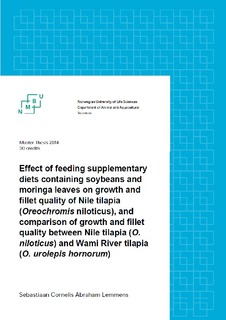| dc.description.abstract | The primary object of this study is to compare effects of various diets and tilapia species on growth performance and fillet quality. The secondary objective is to evaluate which diet could serve as a good alternative for usage in Tanzania´ backyard farming and perhaps in the planned breeding program of GIFT tilapia at Sokoine University of Agriculture (SUA).
The trial underlying this report was performed at SUA in Morogoro, Tanzania, comprising two experiments. Both experiments were implemented based on the following circumstances: Each of the 15 tanks contained 14 fishes in the beginning; however, mortality decreased the number of fish over time. The water was changed every two weeks and no addition of aeration, or other water improvement equipment has been used during the trial. The water temperature averaged 28.3 ± 0.3 °C for both experiments. The dissolved oxygen (DO) levels varied significantly between diets; the Tanzanian diet resulted in an overall higher DO level whereas the Norwegian diet resulted in the lowest DO levels observed. Note, however, once “cow manure” was added to the reference tanks, the overall DO levels lowered significantly. “Cow manure” was added twice a week.
The experiments were performed with triplicate parallels. The first experiment was based on three different diets. One diet consisted only of maize bran and served as the reference diet, whereas the Tanzanian diet contained 34.5% moringa meal as alternative protein source. The third diet, the Norwegian diet, contained 19.6% soybean meal as alternative protein source. The tilapias used in the first experiment were wild Nile tilapia (Oreochromis niloticus) caught from Lake Victoria. The second experiment that started 1 month after the first experiment and only fed on Tanzanian diet, was set to compare the growth performance and fillet quality of the wild Wami River tilapia (Oreochromis urolepis hornorum) against the Nile tilapia.
The mean thermal growth coefficient (TGC) was found to be 0.5% for the Norwegian diet and 0.4% for the reference and Tanzanian diets. The TGC for the Wami and Nile tilapia from the second experiment were 0.2%. The weight gains during 14 weeks of feeding for the diet experiment were, respectively: 27.1, 15.9 and 20.4g for the Norwegian, reference and Tanzanian diets. The weight gain from the second experiment during 14 weeks of feeding was 6.5g for the Wami tilapia and 11.1g for the Nile tilapia. The tilapia fed on the different diets showed little differences in fillet quality. The condition factor (CF) for the different diets did not show a significant variation; in the Norwegian fed tilapia it was 1.7% while the other two diets had a CF of 1.6%. The fillet yield of the gutted weight was 41% for the fish fed on the Norwegian diet while 38% for the other two diets. The fillet yield gutted weight for the Nile tilapia and Wami tilapia in the second experiment were somewhat higher with 43% and 40%, respectively. The fat content in the fillets of the first experiment did varied according to the different diets: the Norwegian diet with 2.2% and the reference diet with 2.3% seemed to give fatter fish than the Tanzanian diet with 1.7%. For the second experiment with the Nile tilapia and Wami tilapia, the results were 1.7% and 2.2%, respectively. It seemed also that the tilapia were able to synthesise the available fatty acids in the dietary feed to the required long chained fatty acids 20:4 n-6, 20:5 n-3 (EPA) and 22:6 n-3 (DHA).
The colouration of the tilapia was very similar between diets and between species; the Nile tilapia fed with the reference diet and the Wami tilapia fed with the Tanzanian diet did show a higher value for yellow in the muscle. The fatty acids profile indicated that the tilapias had an ability of synthesising the linoleic acid to the long-chained arachidonic acid (20:4 c-6) and α-linolenic acid (18:3 n-3) to eicosapentaenoic acid (EPA 20:5 n-3) and docosahexaenoic acid (DHA 22:6 n-6). These fatty acids are relevant for tilapia in forms of healthiness. | nb_NO |
